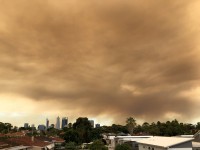Extreme weather, fires prove the need for proper maintenance funding
Tuesday 06 Feb 2018With the first month of 2018 in the books, it’s already shaping up to be a year of extreme weather events.
This January, we saw bushfires in the Perth Hills darken the sky at noon and fill the air with ash and burning embers, only to give way to the remains of Cyclone Joyce delivering four months’ average rainfall in one day. The Department of Fire and Emergency Services received more than 330 calls for help as the high winds and heavy rains did their damage.
Regional areas across the state had to deal with freak thunderstorms, with the town of Cunderdin hit with winds of up to 128km/h that snapped power poles at the base, felled dozens of trees and ripped the roofs off buildings.
Last week we saw three separate bushfires in Gidgegannup, Augusta, and King’s Park put home and lives in danger, while in the north heavy rainfall caused extensive flooding as Broome received more than 400mm of rain in one day.
West Australians know that the Australian weather is often inhospitable but it’s rare to see such extremes on both ends of the spectrum in such a short amount of time. The conditions of this week well and truly put Western Power’s emergency response crews to the test.
Despite the challenges, these crews performed admirably, deploying across the Perth metro region and the southwest to restore power to more than 1,300 homes and quickly moving to neutralise dangerous fallen lines and repair felled power lines.
It’s a credit to the men and women of those crews that they’re still able to do their jobs so well. Under the Barnett Government, maintenance and field staff were drastically cut back.
Between April 2016 and the February 2017, more than 500 staff were let go, reducing Western Power’s workforce by almost 20 per cent via redundancies and not replacing workers.
Crucially, the number of afterhours faults and repair crews were halved.
Those cuts might have made Western Power a more attractive asset to potential buyers, but the effects were immediate and severe. Lower staffing levels will mean cuts to preventative maintenance, longer waits on the phone and longer response times when things go wrong.
The events of the last month were unexpected but mercifully brief, and while the rain did cause power outages and storm damage, it also helped contain and prevent the spread of bushfires.
But how will Perth fare when it is hit with a major winter storm? In November last year, thousands of homes and businesses in Kalgoorlie were left without power for days as a severe thunderstorm downed more than 170 powerlines, leaving the hospital without power for a period of time.
And while cyclone-powered storms are a real risk, bushfires are the bigger threat of the season.
It almost defies belief that by the next summer, Colin Barnett and Mike Nahan were taking the axe to these crews. It’s a simple equation. Less preventative maintenance means an increased risk of fire caused by faulty assets. In pursuit of a quick profit, they were willing to put lives and homes at risk.
The former government did not heed the tragic example of Victoria. The failure of the privately-owned electricity system to invest in proper maintenance of poles and wires was found to be a direct cause of the 2009 Black Saturday bushfires, which saw 173 lives and countless homes lost.
The former government might have thought making a quick buck was worth putting communities at risk by cutting back essential maintenance staff and preventative work.
The people of Western Australia overwhelmingly rejected that idea at the 2017 State Election.
We voted to keep Western Power as a public asset because we know how vital proper investment in preventative maintenance and emergency response is for the safety of our homes. We’ve seen what happens when privatisation puts profits before people.
We don’t know what the rest of the summer has in store for WA, but we do know that extreme weather events are becoming more and more common. We can’t change the weather but we can do everything we can to make sure we’re ready for the next big storm. And if we invest properly in proactive preventative maintenance, we can do everything we can to stop the next big fire from putting us all at risk.

